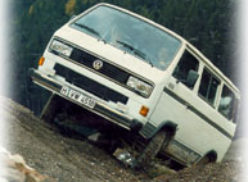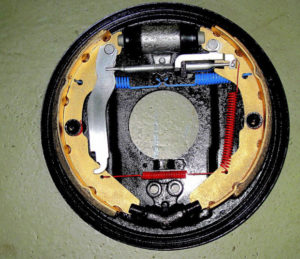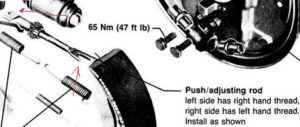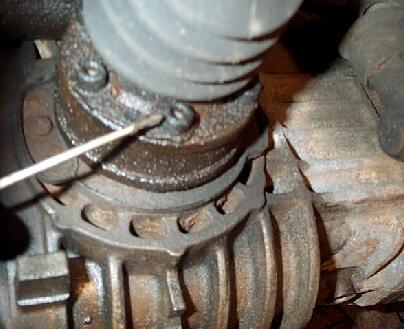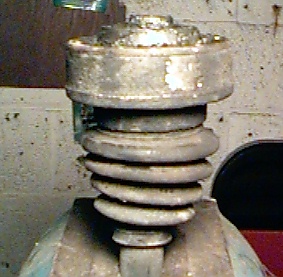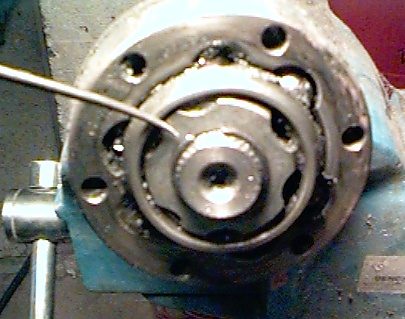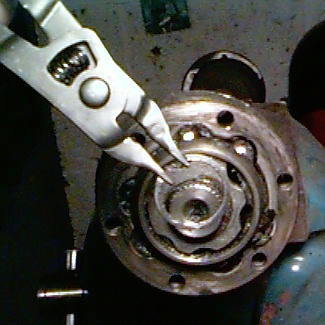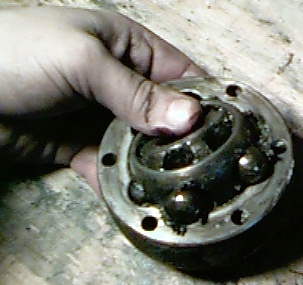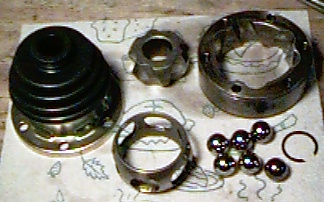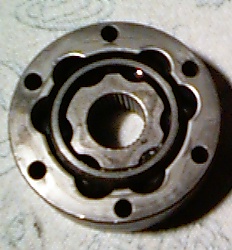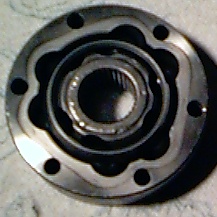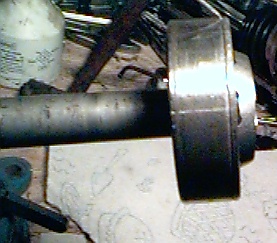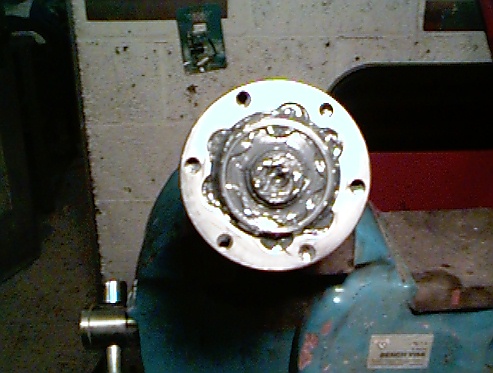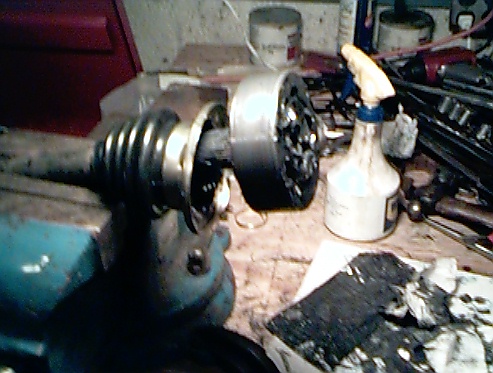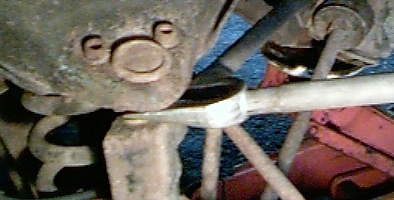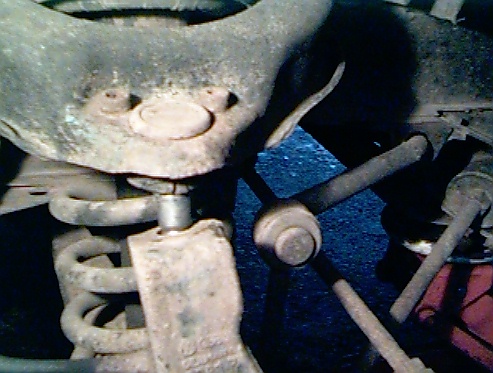By Tom Carrington
With the passing of my Bug in 1987, I was VW-less for several months until bought a 1980 Vanagon. What a wonderful vehicle! I am still hooked on those things today. I sold it after a few years to purchase another VW, this time a 1965 Notchback.
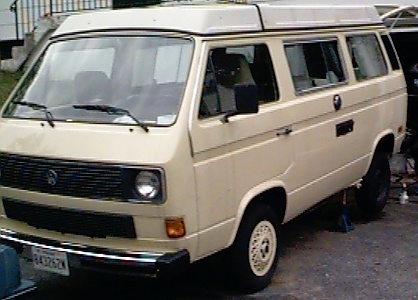
Today, I still own the Notchback, and now also have a 1982 Diesel-powered Westfalia Vanagon. This is a vehicle I have lusted over for several years.
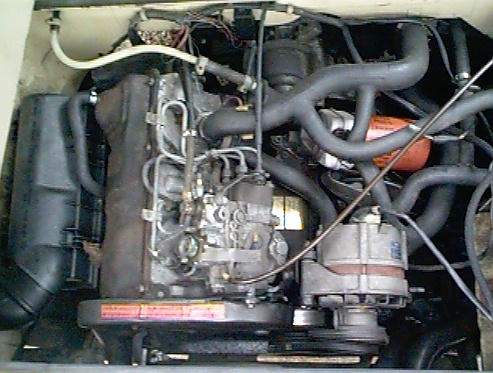
The main reason that I wanted this specific model was the engine conversion possibilities. This picture shows how the Vanagon diesel engine is basically the same engine as the Rabbit diesel, just tilted over on its side. And since the VW diesel engine is similar to a VW gas engine, I have always wanted to install a Rabbit/Golf GTI engine in a Vanagon.
Well, that project is now underway!
Saturday, October 26th, 1996:


I removed the diesel engine from the Vanagon. I decided to remove both the engine and the tranny together as a single unit. The collapsible engine hoist that I bought from Harbor Freight Tools was a big help in removing the engine.
All told, it took me about 4 hours to remove the engine and tranny as an assembly, and separate them once out of the Vanagon. I also removed the muffler. If I had to do it again, I would remove the muffler while the engine was still in the car. I also removed the alternator just to get another spot to attach the hoist’s chain to.
Another thing I noticed when removing the engine/tranny, is that the grease in the CV joints was nearly dry. I guess now will be the easiest time to service them. I plan on replacing all of the boots (even though they look fine, they are almost 15 years old) when I repack the joints.
Sunday, November 3rd, 1996:
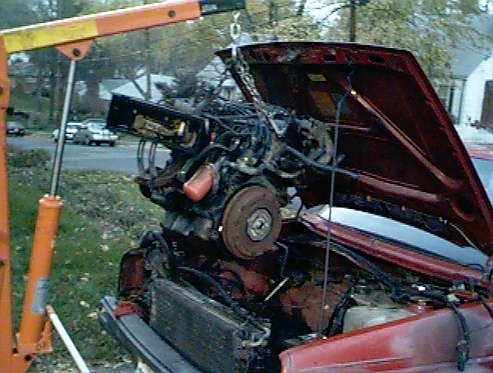
I removed the gas engine from the donor 1986 VW Golf. Removal was pretty straightforward, with just some minor “persuading” so separate the engine from the transmission. Now the task of transferring parts (exhaust manifold, oil pump & pan, etc.) from the blown diesel engine to the gas engine can begin. I also plan on replacing the O-ring seals on the fuel injectors.

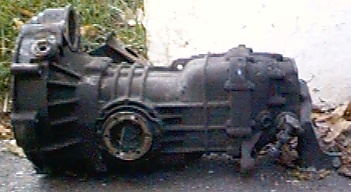
I also snapped a few pictures of the diesel 4-spd manual transmission. It is essentially the same as the gas-engined models, except it has different gear ratios, bell housing and input shaft. I will be swapping the bell-housing and input shaft over to a transmission from a gas powered Vanagon before re-installing the engine.
Sunday, November 10th, 1996:
Today I removed components from the diesel engine that need to be transferred to the gas engine. I also spent time degreasing the gas engine that will be installed. No cool pictures, though. 🙁
Saturday, November 16th, 1996:
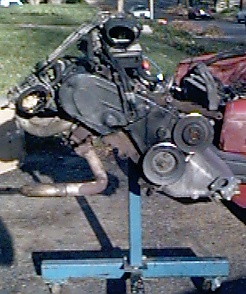 Got a lot of work done today! I started by installing the oil pan & pump and exhaust manifold on the gas engine. I have decided to retain the stock diesel exhaust system, as opposed to fabricating a custom exhaust for the van.
Got a lot of work done today! I started by installing the oil pan & pump and exhaust manifold on the gas engine. I have decided to retain the stock diesel exhaust system, as opposed to fabricating a custom exhaust for the van.  As you can see from the picture to the right, the diesel manifold (on the left in the photo) is quite different from the gas manifold. There is no doubt that the diesel version is much more restrictive than the gas exhaust. While this will probably hurt the performance slightly, it will make for an easier install. If I am not happy with the power after test driving, I might consider swapping then. I also replaced the fuel injector O-rings. The gas engine is looking pretty complete, and will be ready to install next weekend!
As you can see from the picture to the right, the diesel manifold (on the left in the photo) is quite different from the gas manifold. There is no doubt that the diesel version is much more restrictive than the gas exhaust. While this will probably hurt the performance slightly, it will make for an easier install. If I am not happy with the power after test driving, I might consider swapping then. I also replaced the fuel injector O-rings. The gas engine is looking pretty complete, and will be ready to install next weekend!
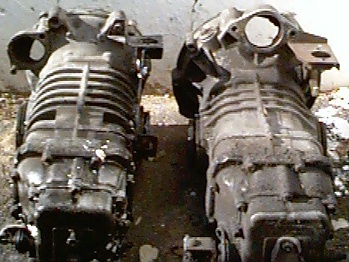
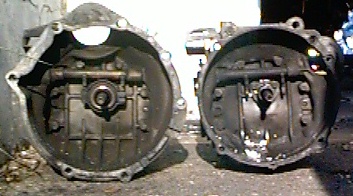
I also received a replacement trans from an early ’80s gas powered Vanagon. Fellow Vanagon Listmember, Ken Wyatt, found it in a salvage yard and shipped it to me for a very reasonable amount. Thanks Ken! I took some pictures of the gas and diesel transmissions side-by-side so the differences would be visible. Note the shapes of the bellhousing to accomodate the different engines & starter motor locations. On the diesel powered Vanagons, the starter is on the top of the trans, and on the gas models, it is down on the side slightly. The gas trans also has thicker and more pronounced ribbing on the case.
I also spent some time sevicing my Constant Velocity, or CV Joints. I took several photos and documented the process on Tom’s CV page.
March, 1998:
An issue with the engine conversion is the low gearing of the diesel transmission. The stock diesel engine output is 48 HP versus the 67 HP of the air-cooled gas engine offered the same year. To compensate, the diesel transmission has lower gear ratios than the gasoline transmission. At highway speeds with the diesel transmission, the engine rpm is quite high. To allow the engine to turn a little slower, I modified the gas-powered Vanagon transmission by installing the bell housing and input shaft from the diesel trans. The process is not too difficult, with only a few special tools needed. I tackled this part of the job during the Memorial Day weekend in 1997.
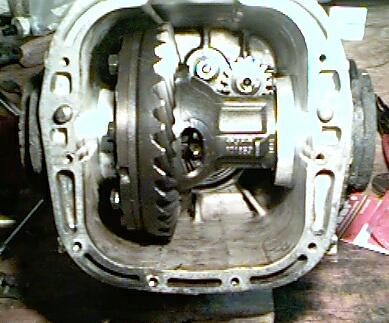
Start by draining the transmission. With the transmission on a workbench, simply unbolt the bellhousing from the transmission. The bellhousing will now slide off the transmission. The input shaft is secured with a small circlip retaining ring. Remove the ring, slide the splined collar/coupling out an inch or so, and unscrew the input shaft. After removal of the input shaft, the tranny will look something like what you see on the left.
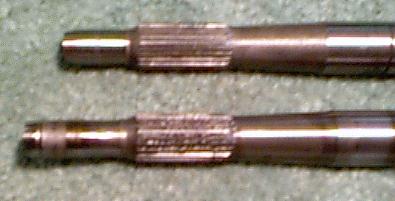 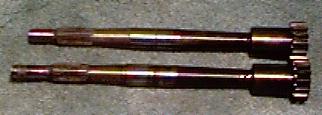 These next 2 photos show the difference between the diesel and the gasoline transmission input shafts. The real difference is that the gasoline shaft is a little longer than the diesel shaft. They are both the same diameter on the end, so it would stand to eason that if you could not find a diesel shaft, the gasoline version could be shortened by a competent machinist. The picture on the right shows the shafts with their collars/coupling. The picture on the left is a close-up of the end of the shaft that will ride in the engine’s pilot bearing. These next 2 photos show the difference between the diesel and the gasoline transmission input shafts. The real difference is that the gasoline shaft is a little longer than the diesel shaft. They are both the same diameter on the end, so it would stand to eason that if you could not find a diesel shaft, the gasoline version could be shortened by a competent machinist. The picture on the right shows the shafts with their collars/coupling. The picture on the left is a close-up of the end of the shaft that will ride in the engine’s pilot bearing.
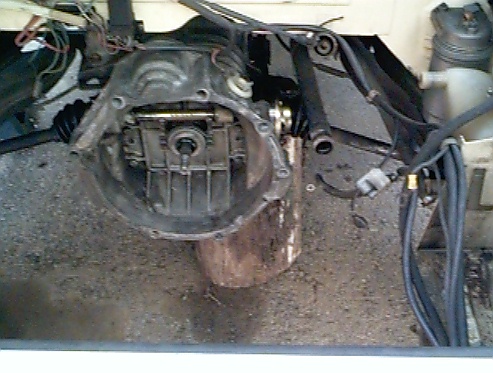
After swapping the input shafts, I installed a new seal for the input shaft in the diesel bellhousing, and installed it on the gas transmission with a new gasket. After refilling the transmission with oil, I went ahead and re-installed it in the Vanagon. I had removed the engine and transmission as a single unit, but I decided to install them separately. The idea was that I would be able to move the engine around easier while installing without the extra bulk of the tranny. With the engine out of the van, it was an easy job to get my freshly repacked CV joints and axles installed as well.
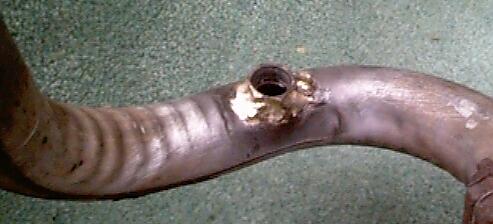
I also did some work on the engine during the Memorial Day weekend. The stock fuel injection from the Golf uses an oxygen sensor to control the fuel mixture. Since there was no fitting on the diesel exhaust, I modified it to accept a sensor. I went to the local Pep-Boys store, and purchased an universal oxygen sensor. The threads were the same as a spark plug (18mm), so I trimmed one of those spark plug “no-foul” adapter sleeves down to a threaded flange. I then drilled a hole in the exhaust pipe in a location that would be easy to access from under the van. I used brass to braze the fitting to the exhaust pipe. I tried welding it first, but the heat from the torch kept ruining the threads of the fitting.
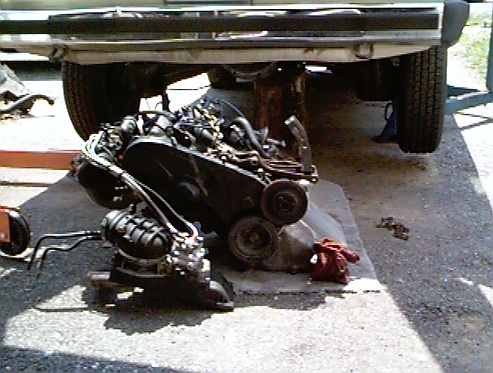
The July 4th weekend of 1997 was the next chance I got to work on the Van. With the transmission installed, it was time to finish preparing the engine. I installed a new rear main oil seal on the gas engine, and bolted on the diesel flywheel. It was then that I learned that the Golf does not use a pilot bearing in the crankshaft! Off to the parts store to buy a bearing. After locating and installing a pilot bearing, I was ready to install the engine. First, I used the engine hoist to remove the engine from the stand and lower it onto a piece of carpet on the ground. By tugging on the carpet, I was able to slide it under the rear of the van. Then I used the engine hoist to raise the engine up into the compartment.
Raising the engine and mating it to the transmission was a relatively simple task. I loosely installed two of the engine mounting bolts. Once the engine and trans were coupled together, I removed the bolts in the front transmission mount to allow me more “play” to move the engine around. As I raised the engine in place, it became apparent that I would definitely have clearance the engine compartment to make the engine fit. On the driver’s side of the van, the intake manifold would not clear the frame rail and the sheetmetal of the compartment.
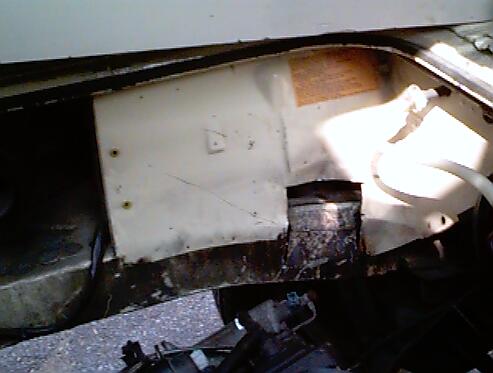
I tried using a 20lb sledgehammer to whack the metal out of the way, but the hammer had no effect. Out came the whiz-wheel (muffler cutoff tool) and the air chisel. I wanted to remove as little metal as necessary, so I would trim a little, then test fit the engine. I repeated this process several times until the intake manifold fit. To the left, you can see the minimum amount that had to be removed to install the engine. Some of the trimming was in the sheetmetal surrounding the engine, and some was actually in the frame member. Whenever I have the engine out again, I will weld gussets into the cuts in the frame.
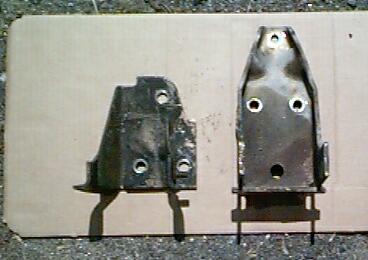
I had a real tough time getting the engine in it’s mounts and the front transmission mount lined up at the same time. It turns out that the two different transmissions each have a different front mount. When I installed the diesel transmission mount on the gas trans, the mount would not line up with the bolt holes in the chassis. When I used the gas transmission mount, the bolt holes would line up, but the transmission was too high under the van and would not fit. You can see the difference in the mounts by looking at the photo to the right. In the photo, the diesel mount is on the left, and the taller mount to the right is for the gas engine. What I surmise from my hour or so of fighting to install the transmission is that the diesel transmission is slightly longer and mounted lower than the gas engine by about and inch or so. I solved the problem by drilling three new mounting holes lower on the gas transmission mount, and chopping off the top of it where it was hitting the body. After the modification to the gas transmission mount, the transmission fit just fine.
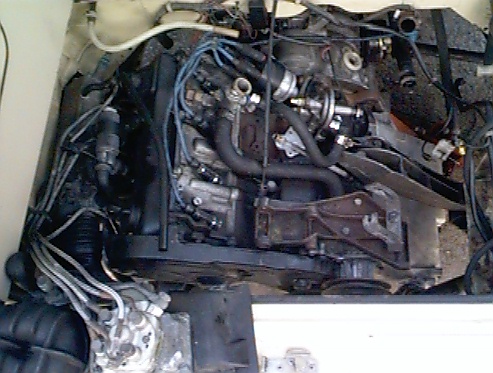
That’s about all that has been done to the van for now. The engine and transmission are installed, and ready for the next phase of the project, which is the installation of the fuel injection, ignition and wiring. In the photo to the left, you can see the installed gas engine. If you look closely, you can see the area of the engine compartment that was cut to accomodate the intake manifold. I spent the Labor day weekend in 1997 removing all of the fuel and ignition system components from the donor 1986 Golf. This includes the wiring harness from under the dash, as well as the fuel pump assembly from under the car. Sometime in April or May 1998, I will start installing these components. Last September, another important milestone was achieved: The rear tires on the Vanagon touched terra firma once again. After nearly a year on the jackstands, the van was back down on all fours!
|
May 23rd-June 1st, 1998: I had last worked on the Vanagon in August of 1997. The engine from the ’86 Golf was installed, but nothing had been hooked up. Thanks to the long Memorial Day holiday weekend, great weather and a supportive wife, I have managed to make good progress on my project. For 2 consecutive weekends, I have managed to spend some serious quality time working on the Vanagon. The results are as follows:
The first issue I had to tackle were the high pressure fuel lines for the fuel injection. These are the stainless steel covered hoses that carry the fuel from the fuel distributor to the injectors on the engine. The problem is that they are several feet too short with the location that I chose to place the air intake/fuel disributor assembly. I went ahead and removed a single line from the engine to see how it was constructed. I knew that I would ruin it, but I figured that I could always stop by the junkyard to get some spares, if needed. The fittings are crimped on to the hose with a metal sleeve. I was able to use a hacksaw to score the crimped metal sleeve, and then split it open with a small screwdriver. It turns out that the hoses are made of plastic with the stainless steel wrapped around them. After pushing back the stainless steel outer braid, I was able to expose the plastic core. I sliced open the plastic core with a new razor blade to remove it from the barbed end of the banjo fitting.
At this point, I needed to find a suitable replacement hose. The inside diameter of the hose is 3mm, and needs to be able to withstand a pressure of 60-70 PSI. I tried local parts stores, speed shops and a hydraulic supply house but came up short. The VW dealer only sold the lines pre-made with the fittings already attached, not by the foot. Fellow listmember, Garth Woolstenhulme, wrote that when he did his conversion that he had high pressure fuel lines custom made byTroutman, an automotive performace shop that specializes in Porsche engines. I chopped off the ends of my old hoses, and sent them to Troutman with instructions to make the new ones 6 feet long. They used the old fittings for comparison purposes only, my lines had new fittings when they arrived. Total cost, including shipping, was under $150. Installing the hoses was easy. After installing the fuel lines I temporarily hooked up the fuel pump. As the pump ran up the pressure, I looked for leaks..none!
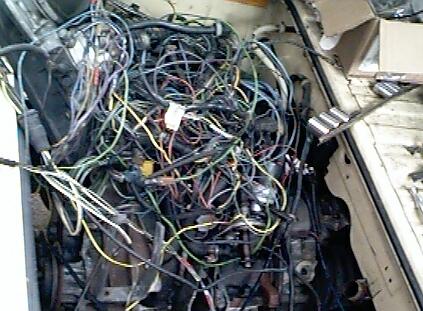 With the fuel lines installed, I started on wiring up the ignition and fuel injection system. I decided to hook up everything outside of the Vanagon, and test run the engine before mounting the components. When I pulled the engine from the donor car, a 1986 Golf, I also got the brain boxes, the entire wiring harness and the components from under the dash. I ended up using the wire cutters to cut the harness, fuse block and relay panel free from under the dash. I had tossed all of this stuff on top of the engine to store it over the winter – what a mess! The next step was to trace the circuits and remove the unnecessary wires. This process was slow and laborious. After many hours tracing the current paths in the Bentley manual for the Golf, I was able to hook up all the ignition and fuel injection components. Time for a test run!!
With the fuel lines installed, I started on wiring up the ignition and fuel injection system. I decided to hook up everything outside of the Vanagon, and test run the engine before mounting the components. When I pulled the engine from the donor car, a 1986 Golf, I also got the brain boxes, the entire wiring harness and the components from under the dash. I ended up using the wire cutters to cut the harness, fuse block and relay panel free from under the dash. I had tossed all of this stuff on top of the engine to store it over the winter – what a mess! The next step was to trace the circuits and remove the unnecessary wires. This process was slow and laborious. After many hours tracing the current paths in the Bentley manual for the Golf, I was able to hook up all the ignition and fuel injection components. Time for a test run!!
Before starting the engine, I removed the coil wire and cranked the engine over. Since the last time the engine was run was in November of 1996, I wanted to establish some oil pressure before starting the engine. To my dismay, the oil pressure light never went out. At this point, I was not sure if I could trust the oil pressure sender, so I removed it and cranked the engine again (and again). I was hoping to see great spurts of oil spraying out of the hole where the sender used to be. Nada. Now I was questioning myself…had I installed the oil pump correctly? Should I pull the oil pan and check the pump? After a few minutes of looking at the old oil pump that I had removed, I decided to remove the distributor and try to spin the pump with an electric drill. I found a socket that fit on the end of the oil pump shaft, and chucked it (along with an extension) into a 1/2″ drill. After spinning the pump for about 15 seconds, I was getting worried- no oil out the sender hole yet. Suddenly, the drill motor bogged down, and oil started spraying out the sender hole! It’s a gusher!! What a relief! I guess the oil pump just needed some help re-establishing its prime. I re-installed the pressure sender and distributor, then cranked the engine with the starter. Oil pressure light went out, just like I hoped for.
The next system to test was the ignition. While cranking the engine, I held the high-tension wire from the coil next to the engine block. I expected to see sparks as the ignition fired. Nothing. I did notice that every time I powered up the ignition module, the coil fired once. After another hour of circuit tracing and testing, I found that the knock sensor was not grounded properly. I cleaned the mounting surface and reinstalled the sensor. This time when cranking the engine, I was rewarded with a nice blue spark.
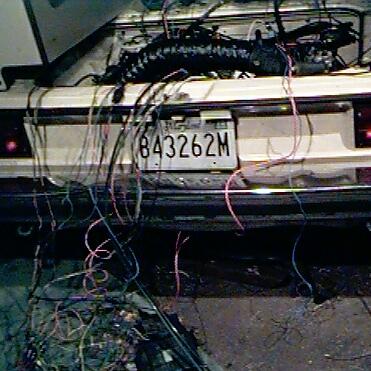 The engine was now ready for starting. I powered up all the ignition and fuel injection components, and cranked the engine over. The engine caught, then died after about 2 seconds. I could repeat this over and over. I was able to keep the engine running by spraying carb cleaner down the intake, so I know that I have a fuel starvation problem. At this point, it was nearly 11:00PM on a Sunday night, and the Van has no muffler. I decided to clean up, and attack the van again next weekend. I’ll pour over the Bentley this week, and try to figure out the fuel injector problem. I could be something as simple as clogged injectors from sitting for over 18 months. If you have any suggestions, please feel free to mail me! Thanks!
The engine was now ready for starting. I powered up all the ignition and fuel injection components, and cranked the engine over. The engine caught, then died after about 2 seconds. I could repeat this over and over. I was able to keep the engine running by spraying carb cleaner down the intake, so I know that I have a fuel starvation problem. At this point, it was nearly 11:00PM on a Sunday night, and the Van has no muffler. I decided to clean up, and attack the van again next weekend. I’ll pour over the Bentley this week, and try to figure out the fuel injector problem. I could be something as simple as clogged injectors from sitting for over 18 months. If you have any suggestions, please feel free to mail me! Thanks!
August 30- September 30, 1998: I took the entire month of September off from one of my jobs, partly to use the extra time to finish the conversion project.
One of the things that bothered me was that the starter motor cranked over really slow. When the diesel engine was still in the Van, it cranked just fine. I checked and cleaned the connections, but that was no help. Then I realized that when I tried to turn the engine by hand, it was very difficult. After messing around with the engine, and even putting 24v DC across the starter in hopes that faster cranking would “free” the engine up, I called in for the reserves – Dad came over to visit. His suggestion was to loosen the bolts holding the engine and transmission together. Turns out the old guy was on to something! When I loosened the bolts, the engine was *much* easier to turn over by hand. The starter motor now spun the motor over easily. Something in the bell-housing of the tranny was binding! While happy to know why the engine was hard to crank, I was not overjoyed at the prospect of pulling the engine out again!
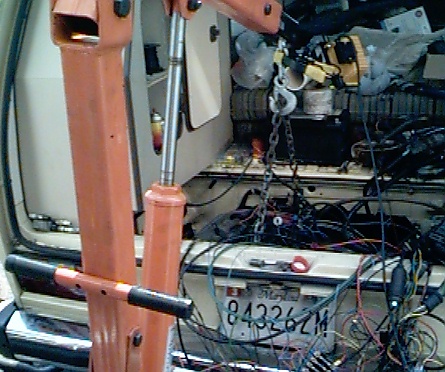
The very next day, I got the engine hoist back out and started pulling the engine. I wasn’t sure what I would find as the problem, and I was hoping for something easy. I lowered the engine slightly, and separated the engine from the trans. It didn’t take me too long to find the culprit.
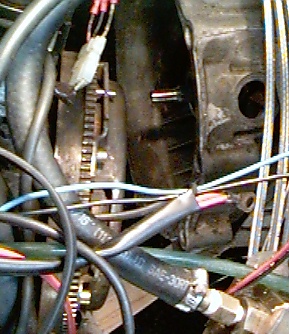
Turns out the transmission input shaft (seen in the center of the photo to the right) was bottoming out in the rear of the crankshaft, causing the engine to bind. I was suprised, as I had taken the time to swap the input shaft from the diesel to the gas t ransmission. Oh well, so much for well-laid plans! I was able to sneak my grinder in between the engine and trans, and less then 10 seconds worth of grinding took off enough (less than .125″) material from the end of the shaft to remove the interference. When I tightened the engine mounting bolts down this time, the engine still turned easily. One big problem solved!
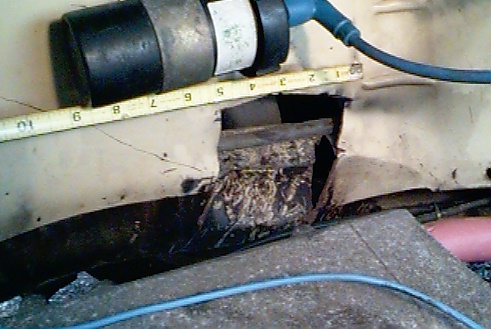
I have had several E-mails asking how much cutting I needed to do in order for the intake manifold to fit. While the engine was lowered down, I snapped another photo. Hopefully, the tape measure will put it in perspective. Remember, I’m American and those numbers are in inches!
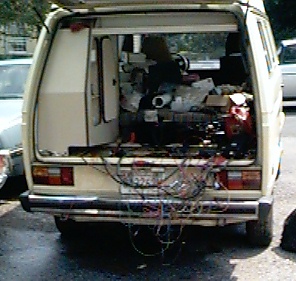
With the engine back in, I hooked up all the electronics and fuel injection components. Gasoline was supplied by a portable fuel tank. A quick hit of the starter, and the engine started right up! I’ve been waiting for nearly 2 years to hear that sound. I let the engine run a few minutes, and then shut it down. Since all the fuel injection and ignition parts were hanging out the back of the van, I still couldn’t drive it around. But I sure was getting closer!
With the engine up and running, I turned my attention to getting all the electrical and fuel injection components permanently mounted in the engine compartment. The big issue to me was where to mount the combination fuel distributor/air intake box. Others that have done this conversion have moved their battery up to under the passenger seat like in the “normal” Vanagons, but my goal was to leave the battery in the stock location.
 There is a nice open area just forward of the driver’s side tail lights, and I decided to put the air intake box in there. The stock air intake box from the donor Golf had no chance of fitting, so I decided to make my own. I started by buying a rectangular “low clearance” exhaust vent for a regular clothes dryer from my local Home Depot. Pictured on the left, this was the starting point for my airbox.
There is a nice open area just forward of the driver’s side tail lights, and I decided to put the air intake box in there. The stock air intake box from the donor Golf had no chance of fitting, so I decided to make my own. I started by buying a rectangular “low clearance” exhaust vent for a regular clothes dryer from my local Home Depot. Pictured on the left, this was the starting point for my airbox.
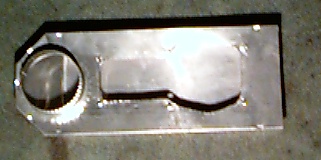
I removed the air flow sensor assembly from the air intake box, and traced its outline onto the dryer duct. Using tin snips, I cut out the metal outline and drilled holes for the 6 mounting bolts.
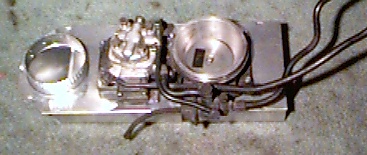 With the fuel distributor mounted onto the modified dryer vent, I squeezed the entire assembly into that small area in front of the driver’s side tail light. A tight fit, but it made it! I mounted the ignition module and other related electronics in the open area in front of the passenger side tail light. What is nice about this setup is that most of the additional accessories are hidden from view.
With the fuel distributor mounted onto the modified dryer vent, I squeezed the entire assembly into that small area in front of the driver’s side tail light. A tight fit, but it made it! I mounted the ignition module and other related electronics in the open area in front of the passenger side tail light. What is nice about this setup is that most of the additional accessories are hidden from view.
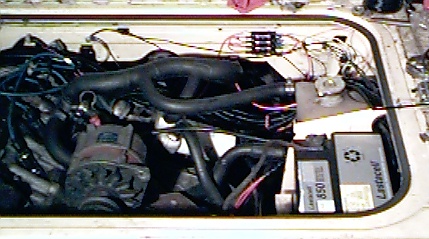
Here’s a few views of the nearly completed project. I secured all the wires, and used plastic wire covers to give the wire harness a cleaner look. Here’s one view of the engine. notice how the battery was retained in it’s stock location.
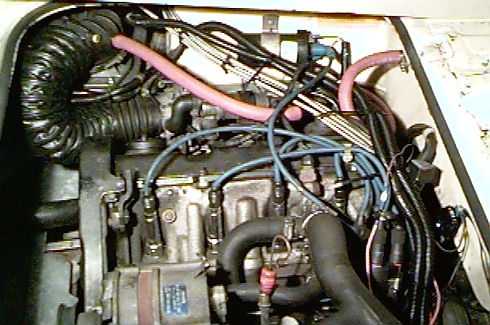
From this view, you can see how the air intake box is tucked down and out of the way, with the large black hose leading to the throttle body. The custom-made, stainless steel braided fuel lines from Troutman are visible here as well. I think this is a clean looking setup. I don’t know why VW didn’t offer this engine option for the USA market Vanagons!
This engine conversion project is getting close to being done. I still need to hook up the throttle cable, finish the fuel system and track down a few electrical gremlins. Unfortunately, the project is on hold again while I get our house fixed up to hopefully sell in the Spring of 1999. I’ll get back to finishing up then. B esides, now I have my Crew Cab Vanagon to play with!
